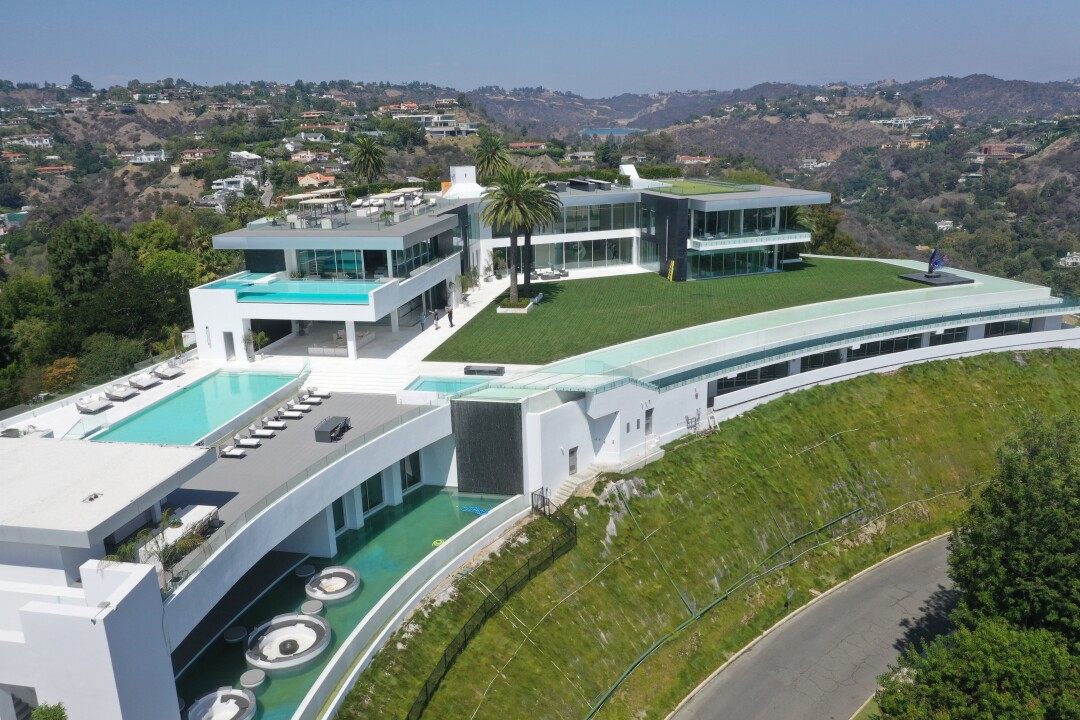It’s hard to grasp the enormity of “The One,” but an aerial photograph of the largest modern home in the United States provides perspective.
Viewed from a drone, the white marble structure once marketed for $500 million looks every bit the fortress towering over the scattered dwellings of a village.
Of course, those diminutive quarters are themselves mansions that climb the hills of Bel-Air, houses that are multiple times smaller than the 105,000-square-foot behemoth hovering above them.
That such a giga-mansion could be built says much about the asymmetrical excesses of our age — in which the struggle for housing plays out in the valleys as spec homes that only a minute fraction of the world can afford rise above them.
It’s also a testament to the will of an obsessive developer driven to build the most extravagant mansion he could imagine — which he now finds slipping through his fingers as he battles a hard-nosed money lender who’s in for more than $100 million on the project.
An aerial view of The One.
(Allen J. Schaben / Los Angeles Times)
Few would mistake the two: Nile Niami, the 53-year-old King of the L.A. Mega-Mansion, has been called “famously bacchanalian” and appears every bit the Hollywood scenester in a recent video, captured in all black, a white beanie and sunglasses.
Don Hankey, a tanned 78-year-old who earned billions making loans to car buyers with bad credit, keeps his gray hair cut short and favors a shirt and a tie.

Don Hankey at the headquarters of his Hankey Group, Westlake Financial Services in the Mid-Wilshire area of Los Angeles. Hankey made billions on subprime loans but now also finances some of the most exotic homes in Los Angeles, including The One, said to be the largest new home in the U.S.
(Allen J. Schaben / Los Angeles Times)
The unlikely duo intersected three years ago when Niami took out an initial $82.5-million loan from Hankey’s real estate lending arm to complete the Airole Way home.
The relationship turned sour after Niami defaulted on the debt and came up with a plan to keep The One in his grasp: living in his creation and turning it into an event space with world championship boxing matches, concerts and a charity event featuring the likes of Michael Jackson and Whitney Houston — in the form of holograms.
Not surprisingly, that didn’t go over with Hankey, whose Westlake Financial is notorious for calling auto loan borrowers if they are one day late on a payment. He filed a foreclosure lawsuit in June against Crestlloyd, the limited liability company established by Niami and his former wife that owns The One.
“I didn’t like it,” Hankey says of Niami’s idea. “We loaned the money to put the house on the market and sell it. We didn’t loan it to take a risk and make it work in some other way.”
Now, instead of pursuing a foreclosure that could leave Hankey owning the property and on the hook for any liabilities, the lender in July persuaded a judge to put the house in control of a receiver. He alleged Crestlloyd failed to complete the project, keep up with property taxes, pay contractors and get a certificate of occupancy. It’s the receiver’s job to resolve those issues.

Mila Scharg, left, Madison Pappas, Nile Niami and Jenny Mandel attend an event in Beverly Hills in 2018.
(Araya Doheny / Getty Images for Victorino Noval)
Niami, whose Crestlloyd also owes millions to other project lenders, doesn’t dispute he didn’t finish the house. He hinted that it was due to not receiving all the promised funds but offered no details because of the litigation.
“It was 1,000% not my fault. It was a matter of funding, and that’s all I am going to say,” Niami says in a phone interview.
With total debt on the home estimated at $165 million, Hankey has been sued by another of Crestlloyd’s lenders seeking to get its own money back. Whether there’s enough to go around remains to be seen.
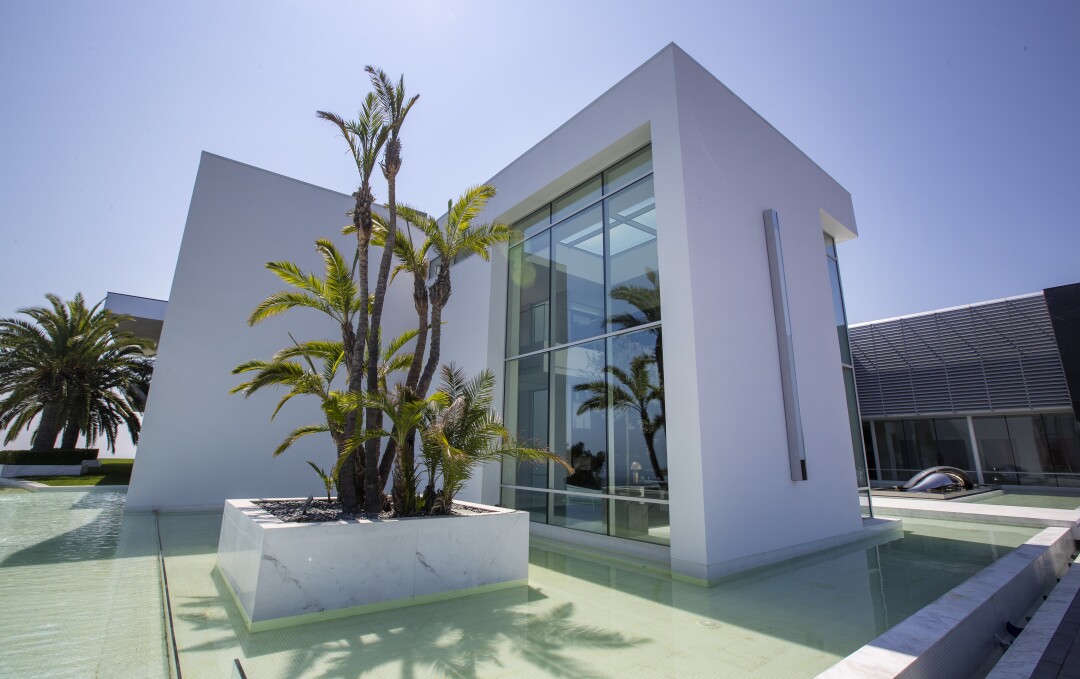
An exterior view of The One.
(Allen J. Schaben / Los Angeles Times)
The home, which Niami marketed for $500 million, has taken a major price cut. It is now going on sale for $225 million after the listing was given to two elite brokerages.
That house is ridiculous to use as a single-family residence. That house should be used to change the world.
Nile Niami, developer of The One
Bel-Air resident Fred Rosen, the former chief executive of Ticketmaster who spearheaded a fight to limit hillside building in the community, called the events plan a no-go for a residential neighborhood. He expressed surprise Hankey extended the loan.
“I can’t comprehend how a guy as smart as he is got taken into this deal. I never called the house The One. I called it The Eleven,” he quips, referring to a well-known chapter of the Bankruptcy Code that does not apply to the house. “It was only a matter of time before it was going there.”
‘An overwhelming experience in luxury’
It’s a curious experience driving up to The One on Bel-Air’s curvy and narrow streets, where mansions hide behind dense foliage. The monumental structure doesn’t come into view until you are directly beneath it, a virtue of its relatively flat design.

A view of “Unity,” an 11-foot-tall contemporary sculpture on a rotating pedestal in the foyer of The One.
(Allen J. Schaben / Los Angeles Times)
The home’s footprint covers the majority of its oddly shaped lot, but the two-story marble-and-glass family living space — with a view that extends to Santa Catalina — is set back from the property line. It looks down on the notorious half-built mansion of developer Mohamed Hadid, which juts from its hillside perch and is set to be torn down because of construction violations.
Hadid’s home across the canyon was dubbed the “Starship Enterprise” by unhappy neighbors and helped spark the revolt that led in 2017 to stricter building regulations. But it’s a McMansion compared with The One, whose name Niami says was suggested by the original listing agent and would prove accurate because it could not have been built under the new regulations.

A view of a 50-seat theater at The One.
(Allen J. Schaben / Los Angeles Times)
The One overloads visitors with its obvious excess. Nine bedrooms in the main house, not counting the 4,000-square-foot guesthouse or servants’ quarters. Multiple pools and a moat. A wellness spa. A beauty salon with washing, cutting and pedicure stations. A cigar room. A four-lane bowling alley. A multiplex-size movie theater with white leather seats. An undulating six-hole putting green on the sky deck. A golf simulator downstairs. A nightclub with VIP seating. A 50-car garage with two carousels to display exotic cars.
It’s staged with expensive artwork and furniture, including a rotating white abstract sculpture designed for the foyer by artist Mike Fields valued at $750,000. But it’s also more subtle. Hand-rubbed Italian lacquer wood in the study. Beige suede wallpaper to soften the effect of the white marble floors.
There’s biometric security and other technology. A custom phone app that controls the house — lights, shades, a TV screen that emerges from a wall. A room of computer servers is on display through a clear door.

A view of the four-lane bowling alley at The One.
(Allen J. Schaben / Los Angeles Times)
“I’ve showed it several times. It’s an overwhelming experience in luxury,” says Shawn Elliott, a prominent luxury home broker.
That’s the intended effect. Niami unveiled the interior to Michael Blakey, a British musician and record producer who runs a successful YouTube channel called ProducerMichael — an internet-era “Lifestyles of the Rich and Famous.” The two-part hourlong tour posted in April has drawn nearly 12 million views.

A view of the indoor pool and living wall at The One.
(Allen J. Schaben / Los Angeles Times)
As he showed off the family kitchen — with a walk-in pantry, Miele ovens and stovetops, and an iPad-controlled coffee and tea machine that stores its own chilled milk — the developer made a telling remark.
“This is one of the many, many, many kitchens, but we have a main kitchen at the lower level. This one probably no one will ever use,” he says, “but it does have very cool things.”
These days the walk-in pantry is stuffed with construction drawings as Ted Lanes, the receiver appointed by the court in July, rushes to finish the property.
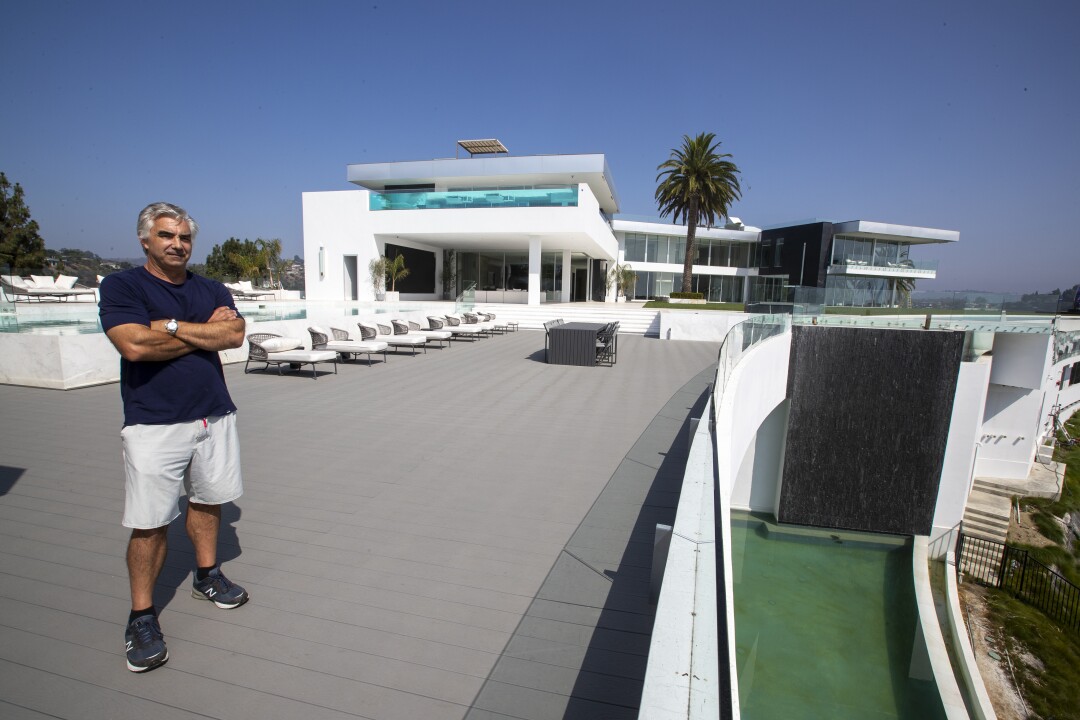
Court-appointed receiver Ted Lanes now controls the property and is in charge of finding a buyer and paying off the lenders and other creditors.
(Allen J. Schaben / Los Angeles Times)
There is much to do: paperwork, paying the unpaid contractors and completing multiple projects. Contractors, whose trucks line the home’s driveway, must finish bathrooms, the heating and air conditioning system, plumbing and electrical. There are repairs too: cracked marble by a pool, construction damage to the nightclub floor and a broken glass sink in a bedroom.
“I’m still getting my hands around what needs to be done to the property in order to satisfy the city,” Lanes says.
The cost for the remaining work: at least $5 million, well more than it costs to build even a large home. But it’s crucial because The One doesn’t have a certificate of occupancy, so no one can live in it.

A view of the office with balcony at The One.
(Allen J. Schaben / Los Angeles Times)
Niami did not come from wealth. He says he grew up a latchkey kid in North Hollywood who helped raise his sister. His mom was a special education teacher who owned a bar in Burbank where she worked most nights. “I am not some rich dude.”
After high school, he worked as a special effects makeup artist in Hollywood before founding a production company with a partner. The company racked up credits, including “The Patriot” with Steven Seagal and “The Watcher” with Keanu Reeves, before he got out of the business.
Niami also was into real estate, fixing up and reselling homes damaged by the 1994 Northridge earthquake. Later, he developed condos but says he was “wiped out” by the 2008 financial crisis. He decided to move into luxury homes, a market less dependent on banks. He eventually partnered with architect Paul McClean, who designed The One and has a signature style of clean lines, white marble and copious glass.
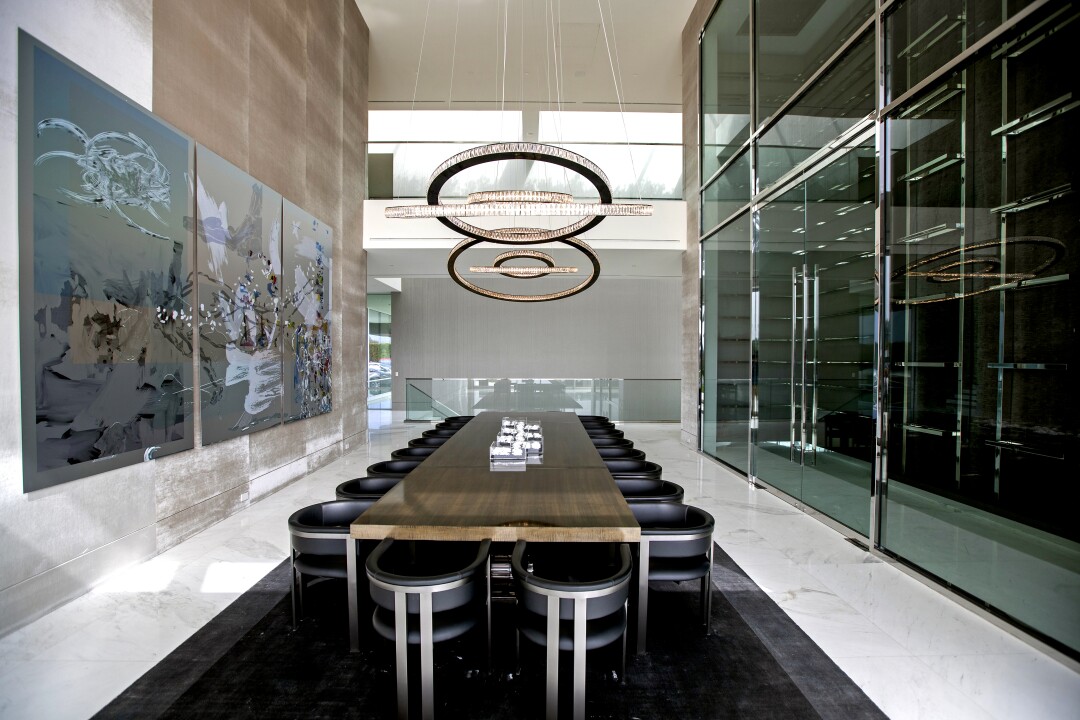
A view of the dining room with a 10,000-bottle wine cellar at The One.
(Allen J. Schaben / Los Angeles Times)
A sampling of reported sales through 2017 is impressive: $40 million for a Holmby Hills mansion with an underwater tunnel to rapper P. Diddy: $38 million for a home in Beverly Hills to billionaire private equity investor Brian Sheth; $25 million for a renovated Beverly Hills home to boxer Floyd Mayweather.
Niami’s homes are desirable, Elliott believes, because they reflect an obsession with detail. “He has a vision and really builds around that vision. He’ll sit on the property, look at the sunrise, sunset, think about the orientation. He is methodical in nature,” the broker says.
With several homes in development, Niami took out the big loan from Hankey in 2018. He wanted more than anything else to finish The One.
“Every single house that I built, that I got money from, I put into that house,” he says.
But Niami says he found himself struggling under the debt as sales of his other homes dried up even before the COVID-19 pandemic. There also had been a building boom by rival spec developers trying to outdo one another. “None of them would sell. Nothing, nothing, nothing,” he says.
A view of the beauty salon at The One.
(Allen J. Schaben / Los Angeles Times)
In December, he placed a Los Angeles spec home on Londonderry Place into bankruptcy One creditor is a lender on The One.
Several months later, the house tour of The One went up on YouTube, along with a third video in which Niami unveiled his plan to pay off its debt: He would live in the house and turn it into a unique event venue.
The pay-per-view boxing matches would generate up to $100 million each. There would be a reality TV show prior to the events chronicling Niami’s interactions with the fighters as they trained on the property or entertainers prepping for concerts.
It would not only make him rich but also fund aspiring entrepreneurs needing a break. He envisioned a charity event called We Are the World 2022 featuring current and past singers. Attendees would be shuttled up from parking lots at the nearby UCLA campus.
“I am going to have the biggest entertainers ever in the history singing on each podium … Whitney Houston, and Michael Jackson, and Prince and Elvis Presley, because every single one of these singers are going to be holograms,” Niami says.
“I think we have the ability to really change the world in a very positive way,” he says.
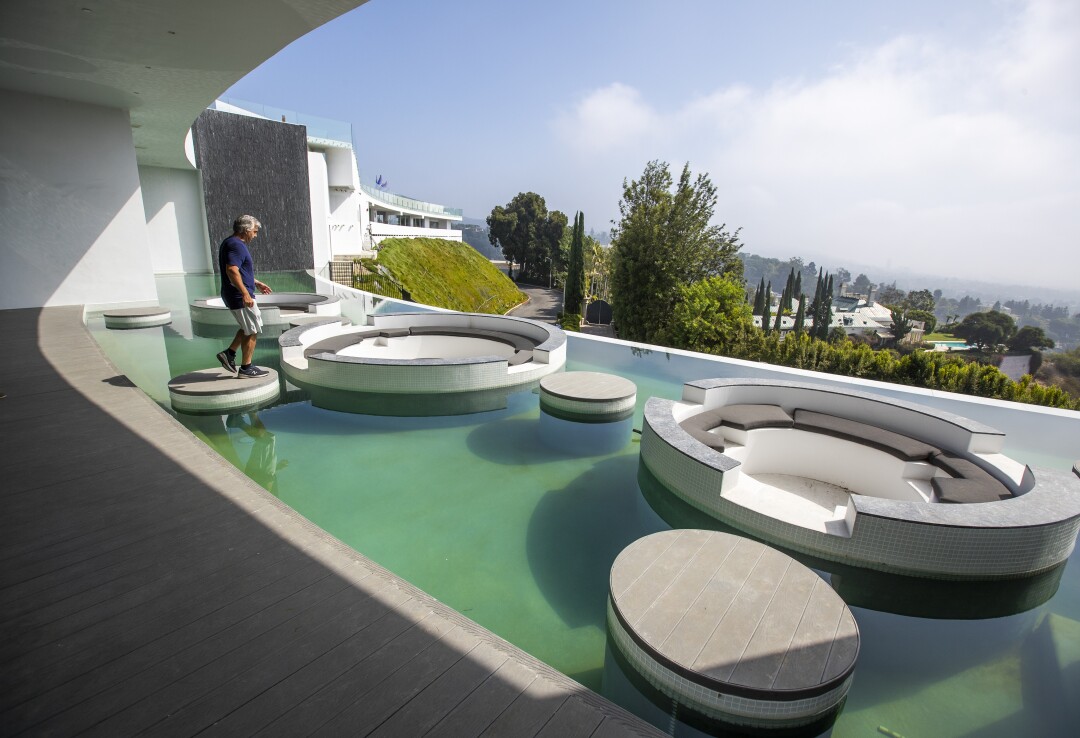
Court-appointed receiver Ted Lanes, who now controls The One, gives a tour of the floating lounge next to the private nightclub.
(Allen J. Schaben / Los Angeles Times)
Niami told The Times he was absolutely serious about the plan and was in discussion with top fighters. He says he met with Hankey repeatedly about it, but the plan never came to fruition after a series of investors who would have paid off the lenders and capitalized the business failed to come through. Niami says one investor even took the money he had put into the deal.
“I sent him $300,000, every single penny that I had. We were going to rain money,” says Niami, who has been sued by American Express for $190,000 in unpaid charges for personal expenses and building supplies, according to court records.
“I’m getting sued by everybody. You know why? Because I don’t have any money left,” he says.
On June 24, two months after the video went live, Hankey filed a foreclosure lawsuit in Los Angeles County Superior Court — his right as a lender whose loan was secured by the property.
In this segment from a series based on the mega mansion “The One,” developer Nile Niami discusses his ambitious plans for the property.
The lender
The Wilshire Boulevard headquarters of Hankey Group seem at odds with a man worth $6 billion who funds lavish homes. The warren of cubicles separated by COVID-era transparent dividers is charitably described by one Hankey Group executive as having a 1990s vibe.
“We’ve revamped that twice, and every time it comes out looking a little weird,” admits Ian Anderson, president of Hankey’s Westlake Financial, his core lending business. “I just think we keep a really humble office.”
The ambience reflects Hankey’s tightfisted approach to his seven companies, which include a Toyota dealership, a dealer management software developer and Midway Car Rental, which does big business renting exotic cars.
That’s not to say money doesn’t flow through the Hankey empire. He’s proud that 43 employees have become millionaires through the company’s stock option plan and 401(k)s. And Hankey doesn’t shy away from luxury himself. He owns two homes in Malibu, including a beachside spread called Xanadu rented out for Hollywood shoots. He’s chauffeured to work every day in a 2016 Mercedes-Maybach S600X, a top-of-the-line Mercedes-Benz with a $192,000 sticker price.
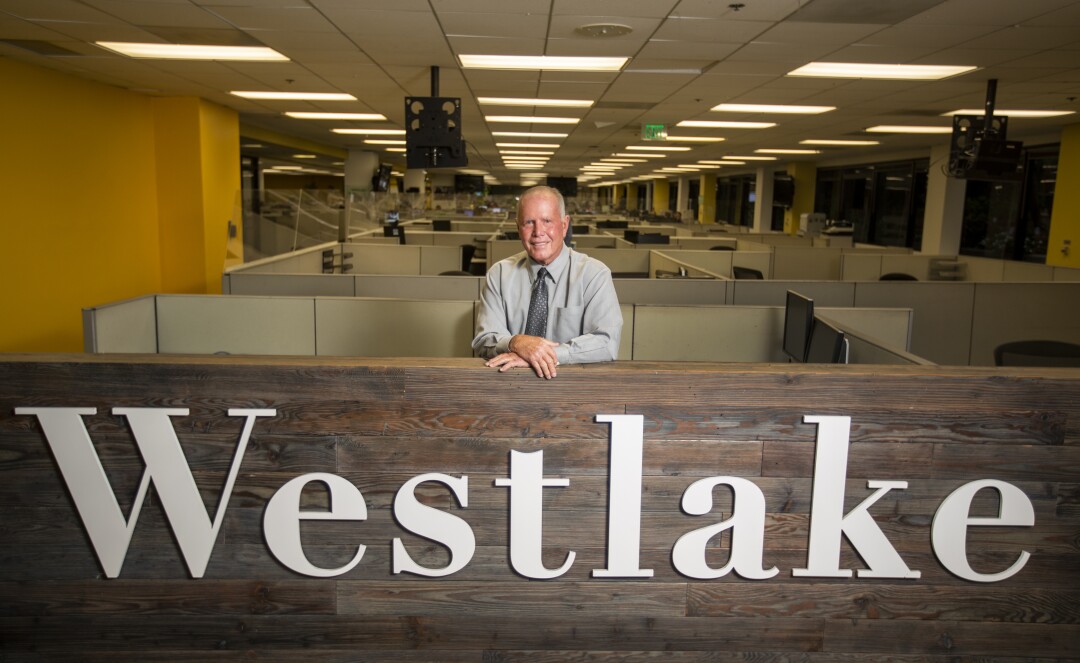
Don Hankey at the headquarters of his Hankey Group, Westlake Financial Services in the Mid-Wilshire area of Los Angeles.
(Allen J. Schaben / Los Angeles Times)
Approaching 80, Hankey makes it to the office by 6 a.m. on weekdays and puts in more time at home on weekends. “He’s a machine,” is how Anderson puts it.
The Los Angeles native studied finance at USC and went to work as a stockbroker, but in 1972 he switched careers and took over a money-losing Ford dealership his late father had co-owned in Koreatown. He found that lending money to borrowers who got turned down by banks because of splotchy credit histories was an even better business than car sales.
These days, Hankey boasts that Westlake Financial is the nation’s largest lender to used-car dealers and makes low-interest loans to buyers with great credit too. Westlake has expanded into other financing, including dealer inventory, solar panels and even elective surgery. It reflects his demands that Hankey Group executives grow their business units 20% annually.
Subprime lending has a grubby reputation, but Hankey sees himself as providing an opportunity to the less fortunate. “If they pay us, well, the next time they get credit from us, or somebody else, our interest rates are gonna go way down,” he says.
Hankey benefits from cheap Wall Street money that costs just a few percent but is lent to subprime borrowers on average at 18.9%, according to Anderson.
There’s a big reason Wall Street banks and bondholders lend cheap to Hankey — because he’s good for it. His companies pay back what they owe, and that’s because Hankey makes sure his borrowers pay him, which has gotten the company into trouble.

A view of a pool with 4,000-square bedroom above it at The One.
(Allen J. Schaben / Los Angeles Times)
In 2015, Westlake Financial and a subsidiary that makes personal loans backed by car titles — a loan typically taken out by desperate borrowers — were put under supervision by the Consumer Financial Protection Bureau and hit with fines and refunds totaling more than $48 million for using illegal tactics to collect on loans.
The federal agency accused the company of making bogus threats to file criminal charges against borrowers, contacting employers, friends and family, and changing loan terms.
Anderson acknowledged at the time that a commission-based compensation system may have led to bad behavior. Hankey says the company has cleaned up its act, with all collection calls now recorded and monitored.
Hankey doesn’t apologize, however, for having his army of servicers call the first day a borrower is late on a payment. Other subprime lenders have been accused of business models reliant on repossessions. Hankey says that is not him.
“That’s the last thing we want to do,” he says. “We lose money on repossessions.”
So far he doesn’t own The One, and presumably he’d like to keep it that way.
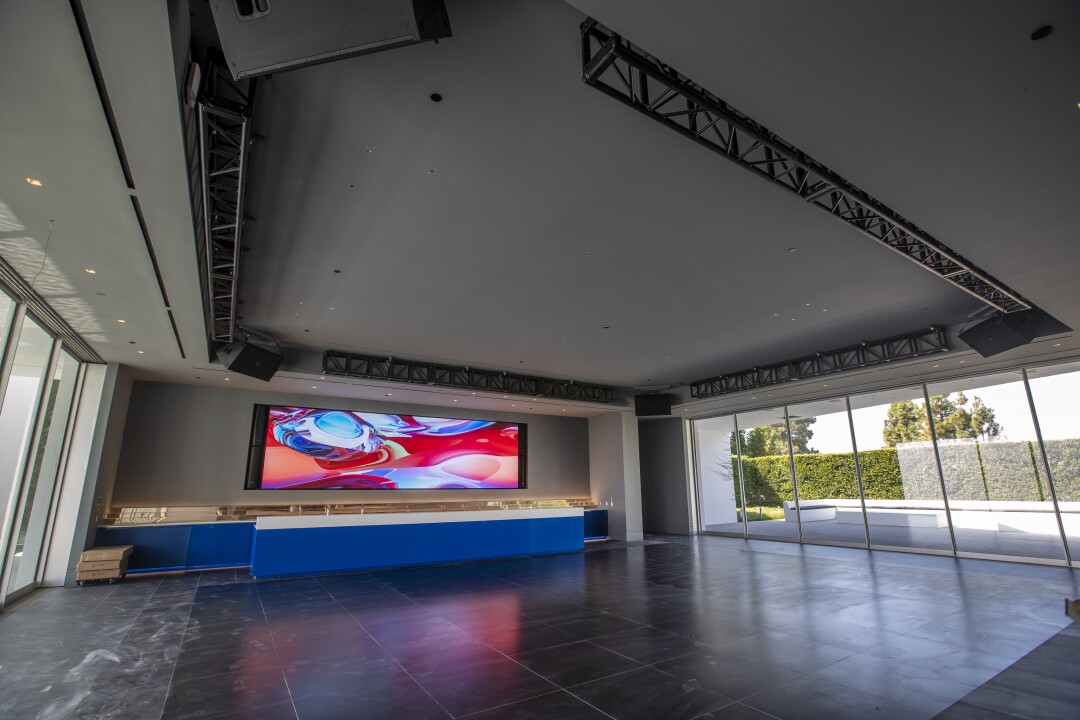
An interior view of the private nightclub at The One.
(Allen J. Schaben / Los Angeles Times)
Hankey has been involved in residential development himself for years, including co-developing the upscale 2-million-square-foot Circa apartment complex across from Staples Center. But that is a far cry from a spec house aimed at a single buyer with $50 million or $100 million to spare.
That’s a business Hankey got into last decade through his Hankey Capital real estate lending unit as the L.A. housing market started to go into overdrive. If you can qualify for a loan from a bank you probably don’t need to come to Hankey, but if you can’t or you need big money fast, he’s your guy.
Hankey Capital is the very definition of what’s called a hard-money lender: short-term bridge loans secured by the property. The website says it this way: Amount funded: $3 million to $100 million. Interest rates: starting at 7%. Points: 0.5% to 2%. Close in as few as five days. Minimal paperwork.
Scott Dobbins, who runs Hankey’s real estate lending and development business, says the profits pencil out when a property sells for $2,000 or more per square foot. “When it’s a 15,000- or 20,000-square-foot house, you are talking maybe $30, $50 million. We’ve done plenty of those $15- to $50-million homes.”
Sitting in his office before a 3-foot-wide curved computer monitor, Hankey counts three residential loans he’s done in the last few years in the $100-million range, including for The One.

The interior of the three-bedroom guesthouse at The One.
(Allen J. Schaben / Los Angeles Times)
It’s a lot of money, so he takes precautions. Real estate loans are generally capped at about 75% of their expected sale value, because he notes that you never know when a deal can go sideways.
“The economy can turn down. Something can go wrong with the project,” he says.
It sounds like he’s describing The One.
Paying a premium
The loan documents attached to Hankey’s June lawsuit detail the bind Niami found himself in.
It had been six years since the developer had bought the property, designed the house, graded the land and started construction. But by October 2018, he still needed more cash to finish up. And he paid a premium for it.
The first loan, which a source close to the project said also refinanced existing bank debt, was $82.5 million with a minimum interest rate of 11%. It included an agreement that should the house sell for more than $200 million, Hankey would get $3.5 million of the sale.
Niami came back a little over a year later and borrowed an additional $8.5 million at the same rate, paying a loan fee of $82,500. He also agreed to more onerous terms: giving Hankey a percentage of the profits if the house sold for $100 million to $200 million.
Two months before the loans were due, Niami came back for a third helping, and got an additional $15 million at the same interest rate. There were no changes to the profit-sharing arrangement, but this time the developer had to cough up a $1-million application fee.
The total: a whopping $106 million that Crestlloyd defaulted on when it all came due on Oct. 31, 2020 — and it’s growing with interest and penalties. But Hankey is not the only lender owed by Crestlloyd, according to a title report provided by the receiver.
There is $14 million owed to entities associated with Julien Remillard, the scion of a rich Quebec family. Niami says Remillard was his best friend for decades and a longtime investor, but conflict stemming from his financial problems soured the relationship.
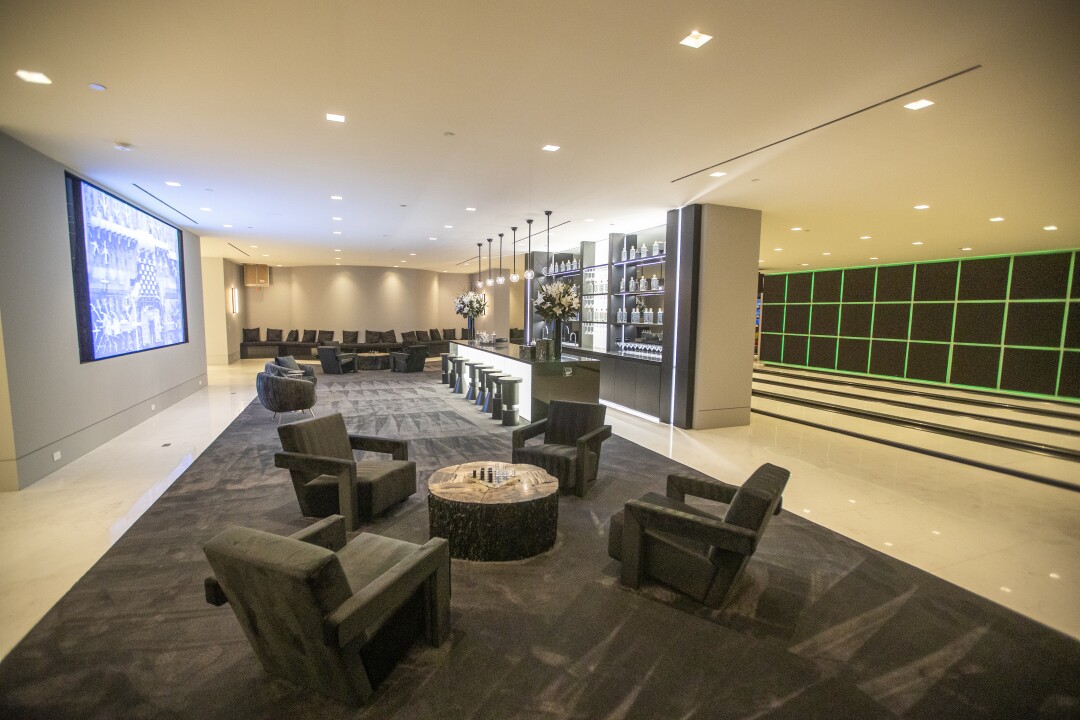
A view of an entertainment room next to the four-lane bowling alley.
(Allen J. Schaben / Los Angeles Times)
And there is $36 million in debt attached to the property by Yogi Securities, an entity associated with Joseph Englanoff, an L.A. doctor who’s been an investor in other Niami properties. Yogi was a creditor on the Londonderry Place house put into bankruptcy.
Niami has different feelings about each partner: expressing hurt about Remillard and other former confidants (“Everybody that I trusted f— me over.”), declining to comment on Englanoff (“Let’s just leave it at that”), but speaking fondly of Hankey.
“Don is a terrific person. What‘s happening is not fair, but Don is a great guy. I have been to his Malibu house several times, and I really like him,” Niami says.
Lanes, the receiver, estimates that with the house carrying $165 million in debt, it could be tough to pay off all the lenders and leave something for Niami and his former wife if it’s sold to the highest bidder by the court — a possibility if a sale can’t be negotiated.
“If there’s a trustee sale, the proceeds to her and Nile are at risk,” he says.
Yvonne Niami said she could not talk about The One on the advice of her attorney.
The fear that there may not be enough money to go around may have prompted Yogi to sue Hankey Capital in June, asserting that any loans extended beyond the initial $82.5 million should be paid after its own debt is satisfied. Attorneys for Yogi did not answer calls and emails for comment.
An attorney representing Remillard said his client declined to comment.
Hankey doesn’t want to talk about his debt or the litigation surrounding it, but he says he feels confident that the house will draw a buyer.

An aerial view of the guesthouse and space for a tennis court at The One,
(Allen J. Schaben / Los Angeles Times)
“Maybe there are only 100,000 people on the planet who could afford and who would be happy living in a house like that. Maybe it’s not for you and I. But there are some people who would enjoy a large house like that,” he says. “I might add it has a spectacular view.”
Of course, the question is the price.
So far the most expensive home sold in California has been the historic Warner estate purchased last year by Jeff Bezos for $165 million. And this year, Niami reportedly sold three mansions in the Hollywood Hills and Bel-Air but for well under their asking prices, including the Londonderry Place home that had been placed in bankruptcy.
A major reduction in its eventual sale price could be the fate of The One too, given its expected listing at less than half its original asking price. Lanes says the listing was given this month to two brokers at Westside Estate Agency and Sotheby’s International Realty, pending court approval.
Opinion about The One isn’t uniform in the broker community.
Elliott, a fan who says he has a potential buyer in mind, figures it could attract a wealthy buyer from the Middle East or perhaps Asia who travels with an entourage. Or perhaps a private corporation that wants a retreat.
“The feeling you get is supposed to be like a resort, like you’re feeling pampered from the minute you walk in,” he says. “You could hold a summit there.”
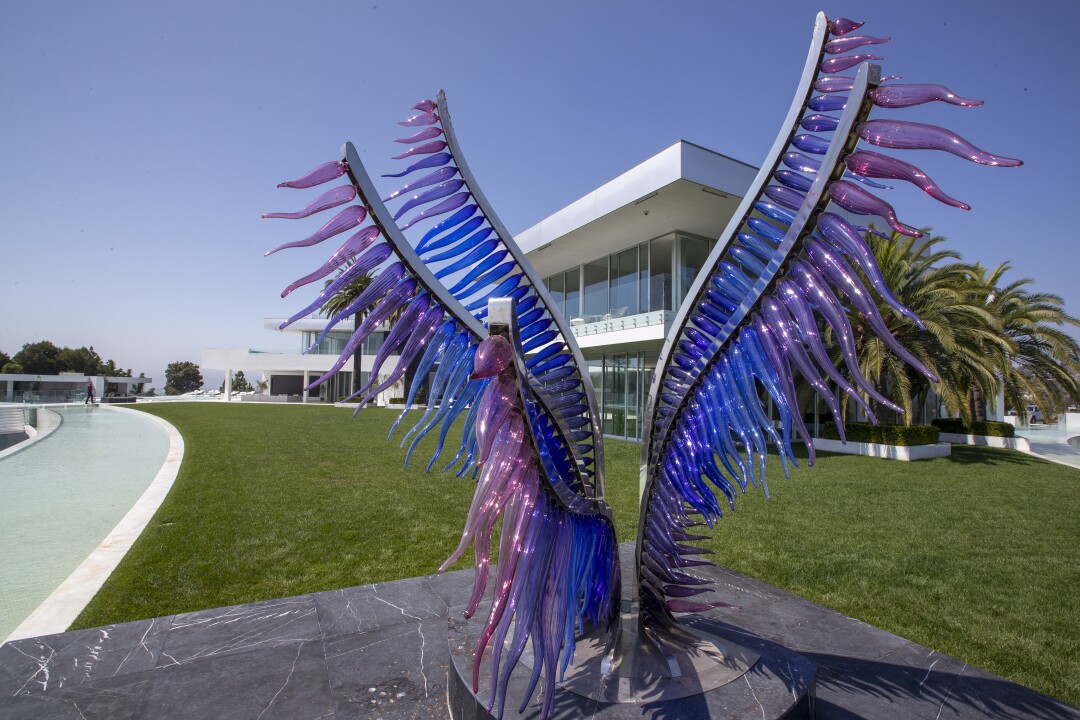
A sculpture by Simone Cenedese stands outside The One.
(Allen J. Schaben / Los Angeles Times)
Stephen Shapiro, whose partner at Westside Estate Agency was given the listing on The One, isn’t so sure there’s a market remaining for a house of this size and design.
“I don’t know the next group of people who buy big soulless houses,” says Shapiro, who made his comments before Westside got the listing. “A lot of crypto guys are buying some houses like that, but nothing of that magnitude.”
Lanes says he’s been inundated with calls from people wanting to tour the property, but he won’t do so unless they show proof of funds and are working with a licensed agent. So far about a dozen have met that criteria and been inside, though it is not formally listed.
“It infuriates people. I got a couple of ‘You don’t know who I am,’” he says.
So far, though, no deal as Lanes works to complete the house and get a certificate of occupancy, which he estimates may take six months. A trustee sale is set for next month, but Hankey says it may be delayed.
Niami told The Times he thinks the $225-million asking price is far too low and still hopes he can make his events idea come to fruition. He’s been in Europe filming a reality television show he thinks is “TV gold” that could turn around his fortunes.
“I pray to God that everything will go terrific with this house, I pray I can still do these pay-per-view events,” he says.
He has soured on the idea of his creation simply being a place where someone lives. “That house is ridiculous to use as a single-family residence,” he says. “That house should be used to change the world.”
Hankey’s long experience in subprime lending gives him a distanced perspective.
Between Westlake Financial and his real estate lending operation, he has close to 1 million loans on his books. At any given time, his company is in the process of repossessing thousands of cars from borrowers who have stopped paying.
“You have to take the good with the bad and hope at the end of the day you’re able to have the positive cash flow and make a profit,” he says.
“It’s just one loan,” Hankey says. Albeit a $100-million one.
Times researcher Scott Wilson and staff writer Jack Flemming contributed to this report.

